Being able to deploy Operating Systems with ConfigMgr 2012 is one of the main reason why companies invest in the product. When deploying an Operating System, you may want to change from the default language preferences. In order to do so, you need to create an Answer File (unattend.xml) that will be used during the deployment of the Operating System. In this post we’ll go through the steps necessary in order to create an Answer File and then how it’s used in a Task Sequence in ConfigMgr 2012.
Overview
- Software requirements
- Create an Answer File
- Use the Answer File to in a Task Sequence
Software requirements
To create an Answer File, you can use a software called Windows System Image Manager. This software is part of Windows ADK. Download and install Windows ADK and when asked which components to install, select only Deployment Tools. In my lab environment I’ve installed a Windows Server 2012 R2 virtual machine called TEST02, and installed Windows ADK 8.1.
Create an Answer File
Before we begin, we need a WIM file for the Operating System that we’re deploying. In this scenario we’ll be deploying Windows 8.1 Enterprise x64, so grab the install.wim file from the sources folder of the Windows 8.1 installation media (extract the contents of a Windows 8.1 ISO by using e.g. 7-zip). In my lab environment I’ve copied install.wim to C:\WIMFiles. It’s important that you copy the install.wim from the installation media, since we’ll be needing Read/Write access to the file.
1. Open Windows System Image Manager.
2. Right-click on Select a Windows image or catalog file in the Windows Image pane, and choose Select Windows Image.
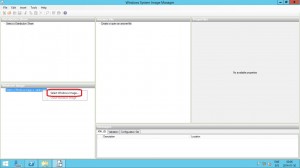
3. Browse to the location where you copied the install.wim and select the file to import it. You’ll be prompted with the message below, click Yes. It will take some time for the catalog to be generated.

4. In the Answer File pane, right-click on Create or open an answer file, choose New Answer File.
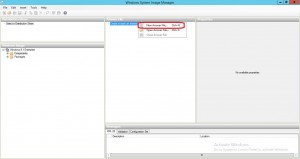
5. In the Windows Image pane, expand Components.
6. Locate the component called amd64_Microsoft-Windows-International-Core_6.3.9600.16384_neutral. It’s important that you select the correct component based on the architecture on the operating system that you’ll be applying this Answer File to. In this case we’ll be using the Answer File with Windows 8.1 Enterprise x64, and that’s the reason why we select the amd64 component. When you’ve located the correct component, right-click on it and choose Add Setting to Pass 4 specialize.
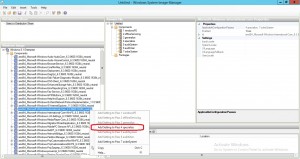
7. In the Answer File pane, make sure that the amd64_Microsoft-Windows-International-Core_neutral is selected under the specialize pass.
8. To the right of the Properties pane, each selected component from the Answer File pane will be shown. Let’s say that we want to change the language settings to Swedish. Under Settings, enter the following in each corresponding field:
InputLocale: sv-SE
SystemLocale: sv-SE
UILanguage: sv-SE
UILanguageFallback: en-US
UserLocale: sv-SE
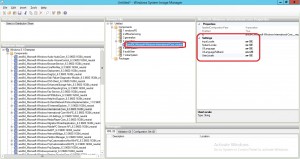
The values of the fields above are considered as strings. If you continue to add different components to your Answer File, you might notice that some fields require boolean values, and you can then only select True or False from a drop-down menu. Check the following link if you would like to know more about the settings of this component:
https://technet.microsoft.com/en-us/library/cc766400(v=ws.10).aspx
If you’re looking for Language Code ID’s, there’s a great PDF from Microsoft available from the following link:
https://msdn.microsoft.com/en-us/library/cc233965.aspx
9. Click on Tools and then Validate Answer File. The Answer File will now be validated. If you made any errors, the will be shown in the Messages pane at the bottom. If the validation returned 0 messages, you’re good to go.
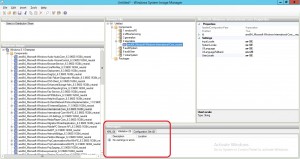
10. Click on File and Save Answer File. Choose a location where to save the file. It’s recommended that you name the file as unattend.xml for future reference. Once the file has been saved, copy it to a folder in your Content Library on the ConfigMgr Primary Site server. In my lab environment that would be:
\\CM01\ContentLibrary$\OSD\AnswerFiles\sv-SE
Use the Answer File to in a Task Sequence
1. Create a new Package in ConfigMgr and specify the source content files to point to the location where you saved the unattend.xml file. I’ve named the package Unattend – Swedish.
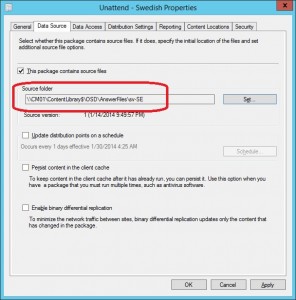
2. Edit your task sequence used to deploy your version of Windows (in this case Windows 8.1 Enterprise x64).
3. Select the Apply Operating System step and put a check mark in the Use an unattended or Sysprep answer file for a custom installation box.
4. Click on Browse and select the Unattend – Swedish package (if you named the package something else, make sure you select the correct package).
5. In the File name field, enter the name of your Answer File. In this case it would be unattend.xml.
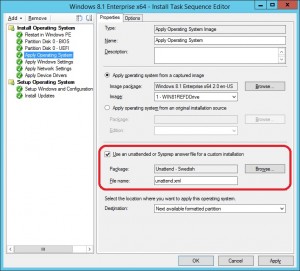
6. Click OK in the task sequence.
7. Deploy a lab VM and once it has installed successfully, your language settings should now reflect the settings that you specified in the Answer File.
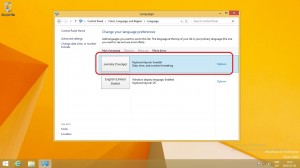









Dude, you saved my life! I’m trying to have Japanese as the default display language/region/location etc (but not system Locale, this must remain en – the OSD works, but the default language shows ‘searching windows update..’ against my default (Japanese) pack – how do I add the language pack/.cab files into the build too so it doesn’t need to search WSUS/win update for the pack?
Great post!
My question is how can you configure your answerfile to prompt for language, keyboard and timezone for Windows 10?
I configured it the same as you did, but ended up with only one language (swedish). I need English as well, because I want the “Windows display language” to be in English. Otherwise, the display name of the apps (Windows 10) are shown in Swedish and I don’t want this (I need them in English). Do you know how I can accomplish this?
Config must be done in section “oobeSystem” and not “specialize”. Otherwise, it doesn’t work for UILanguage.